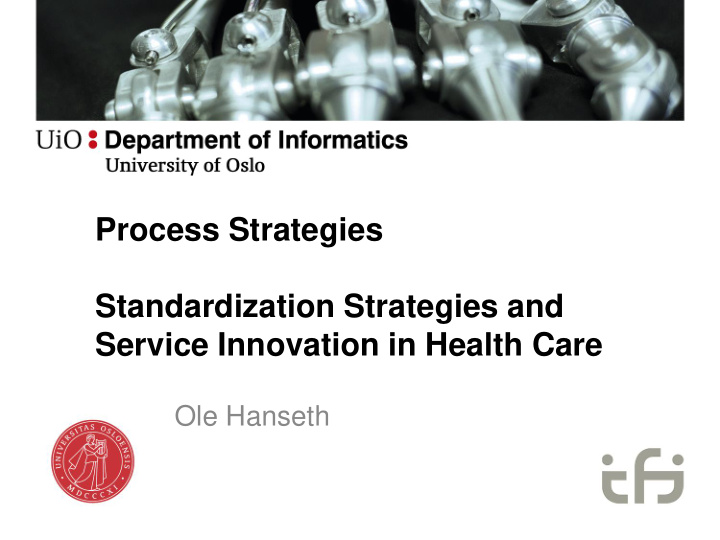



Process Strategies Standardization Strategies and Service Innovation in Health Care Ole Hanseth
Standardization strategies • Standardization: formal, de facto • The formal model (telecom, …) • De facto – «the market» • “A regime in crises” • SAP: Generifization • Flexible standards
The Internet model • – « -- we believe in rough concensus and running code» • Maturity levels – Proposed standard • resolved known design choices – Draft standard • at least two independent and interoperable implementations from different code bases • sufficient successful operational experience – Full standard • significant implementation • successful operational experience
Research question • Which standardization strategies support service innovation in the health care sector? • I.e. which strategies are most successful in terms of, first, leading to the settlement of new standards which are implemented in ICT solutions which eventually are widely adopted , at the same time as the adoption and use of the solutions based on these standards enables and contributes to service innovation ?
The beginning • 1987: Fürst’s lab report transfer solution • 1988: Telenor (Telemedicine in Northern Norway) • Lab report transfer solutions • Standardizing • Statskonsult’s Infrastructure programme: EDI – Physicians’ invoices • CEN TC/251, KITH • Consensus: EDI
Anticipatory standardization • 90-ies: – Lab reports & orders, prescriptions, physicians and out- patient clinics’ invoices, admission and discharge letters, .. 00-ies: – Lab reports & orders, prescriptions, physicians and out- patient clinics’ invoices, admission and discharge letters, ..
Integrated solutions • ELIN projects – Overall requirements • The message effort (meldingsløftet) • ePrescription • Status: Modest successes, coordination problems, always someone not doing as promised
Flexible generification • Fürst – Lab report transfer solution, 1987, 3 man weeks + 1 evening – Lab ordering solution, interactive ordering • Northern Norwegian Health Network – Generification, $-format • Well/Dips Interactor – General interactive ordering – Interactive admission letters – Experimental standardization, flexible standards – Platform
Summary Care Record Systems • Scotland: – 3 MGBP (4M Euros, 4 M USD) • Denmark: – Official, top-down • 10 M Euros, • Faded out after about 4 years, officially cancelled after 8 – Unofficial, bottom-up • Great success • UK – Started 2004, early adoption 2007, further deployment is frozen – Spent 240 MGBP
Architecture & governance regime • AP: INA, complex organization • IS: INA, complex organization • FG: SPA, simple organization
Table 2. Standardization strategies Description Cases Standardization strategy 1.Anticipated Top-down process, 1. CEN TC/251, standardization worked out as KITH detailed compromises 2.ePrescription (1) 2.Integrated User driven projects, 3. The Elin project solutions 4. ePrescription (2) standards part of requirements specifications 3.Flexible Work processes and 5. Fürst generification actual use determine 6. NNHN 7. DIPS Interactor standards, adapted pragmatically
Service innovation • Anticipatory standardization – Replicating paper based services • Integrated applications – Replicating paper based services • Flexible generification – New and improved services
Thank you!
Recommend
More recommend